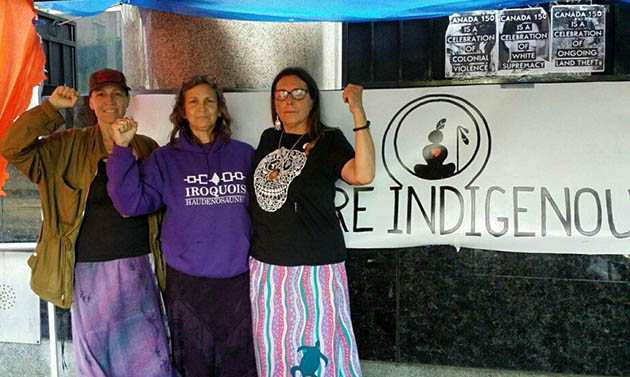Toronto Vigil for Indigenous Youth in Crisis going into fourth week

By Barb Nahwegahbow
TORONTO – It’s nearing the end of Day 23 of the Vigil for Indigenous Youth and Children in Crisis at Toronto’s office of Indigenous Affairs at 25 St. Clair Avenue East. It’s a Saturday evening, August 12 and spirits remain high among the three Haudenosaunee women – Carrie Lester, Sigrid Kneve and Sue Lynn Manone – who’ve organized the Vigil and ensure a 24-hour presence. They’re outraged that the government hasn’t taken swift and decisive action about the rash of suicides among Indigenous children and youth in northern First Nations communities. Would the government drag its heels if these were non-Indigenous kids taking their lives, they wonder. Since the Vigil started on July 20, there have been at least four more suicides that they know about.
The women have set up a neat and increasingly well-equipped camp site in front of the building. There’s wooden shelving for their pantry, a table to serve meals and a canopy for their seating and sleeping area. Lester and Kneve say that everything they need shows up magically. Spirit provides, they said. Men from the community have shown up to watch over the women when they sleep.
People drop off food, so much of it in fact, that one afternoon they put out a table laden with muffins and cookies with a sign that said, Free Baked Goods. Many of the passerby, even the rich ladies in the neighbourhood which is also Minister Bennett’s riding took a chocolate muffin or two to have with their afternoon tea, says Kneve, laughing.
There’s an atmosphere of calmness and hospitality in the camp. The medicines and a smudge bowl are on a table under the canopy and a candle provides their sacred fire. Indigenous flags fly next to the Canadian flags on the building. There’s a red dress representing MMIWGT2S, and flip chart papers loaded with statistics of suicides and children in care. Some people are visibly moved when they read the horrendous facts, said Kneve, and they rush home to email the Prime Minister and Ministers. Some of them return with copies of the emails they’ve sent. For easy reference, the women have posted on the wall, a paper with the names of federal and provincial Ministers.
“We’re here for the children,” said Sue Lynn Manone, “and we’re here to keep vigil for those mothers and grandmothers who are so far away in those remote communities. If I was in their shoes, I’d wonder if anybody hears my pain or feels my pain. As a mother and grandmother, I want them to know I do. That’s why I’m here.” Some of the women have lost more than one child to suicide. Manone cannot imagine the pain of losing one child, let alone two. “It has to stop,” she said.
“This is a sacred space,” she said of the camp, “because it’s for the children. It’s not about us and we want to make sure that message is loud and clear.” The women have zero tolerance for violence, alcohol or drugs. They have distributed about 700 pamphlets to passerby and make every effort to engage in respectful and deep discussion with those who stop. For the majority of people, said Manone, “it’s been an awesome reaction in the sense that we’re starting to affect them in their hearts by having meaningful conversations and clearing up any misconceptions or questions they might have.”
“We are taking direction from the youth,” she continued. If the youth send word that they want us to stop, then that’s when we will stop. But in the meantime, we will keep the pressure on these guys in the government. And if the youth want to come down, this space is available for them and we will step out of the way and give them that platform. We don’t have a lot of platforms out there to have our voices heard, to tell our stories.”


